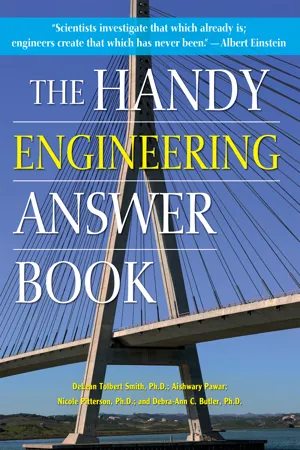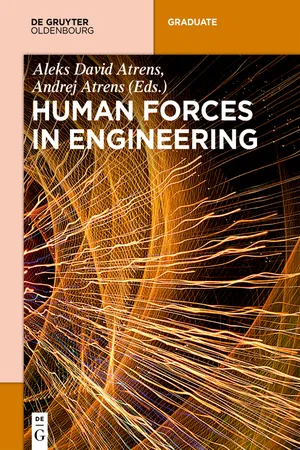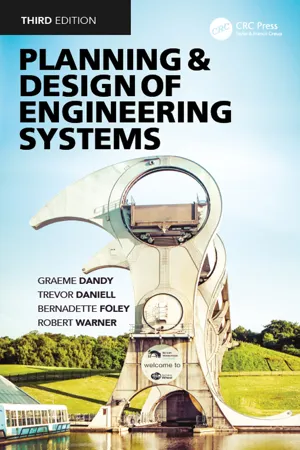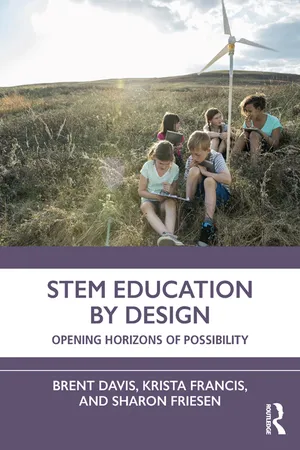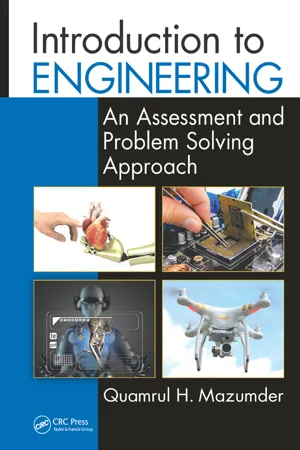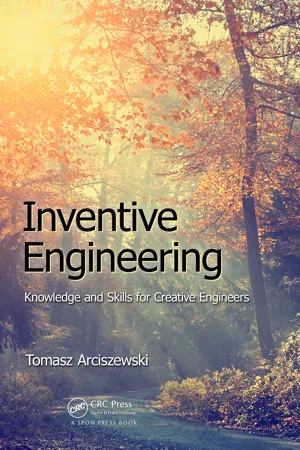Technology & Engineering
Importance of Engineering
Engineering is crucial for solving complex problems, designing innovative solutions, and advancing technology. It plays a vital role in creating infrastructure, developing new products, and improving processes across various industries. Engineers apply scientific principles and technical knowledge to address real-world challenges, driving progress and shaping the future of society.
Written by Perlego with AI-assistance
Related key terms
10 Key excerpts on "Importance of Engineering"
- eBook - ePub
- DeLean Tolbert Smith, Aishwary Pawar, Nicole P. Pitterson, Debra-Ann C. Butler(Authors)
- 2022(Publication Date)
- Visible Ink Press(Publisher)
Introduction to Engineering
What is engineering?Engineering is a branch of science that deals with the application of mathematical and scientific principles. It is also a discipline and profession that meets the needs of society. Engineers incorporate interpersonal skills such as teamwork, creativity, decision making, ethics, leadership, and design to create solutions to societal problems and improve daily life. People who work in engineering analysis generate and gather data that they use to think critically, make decisions, and create new knowledge. To accomplish these goals, engineers need a strong background in science and mathematics.Engineers work in many different types of work settings. They can be found wearing hardhats on a construction site, on a farm improving agricultural technology such as dams or water reservoirs or developing biofuels from food. Engineers can also be found in fancy offices while helping businesses develop models that can predict their future success.Where does the word engineer come from?The word “engineer” is derived from the Latin words ingeniare and ingenium. Ingeniare means to create, generate, contrive, and devise, and ingenium means cleverness.What is the goal of engineering?The primary goal of engineering is to make people’s lives better. In this regard, engineers seek to identify problems with practical significance to local and broader contexts. Through their work, engineers endeavor to make technological advances using innovative techniques along with their application of mathematical and scientific knowledge. The goals of engineering can be broken down into two main categories: creating processes and designs and maintenance and operations.Engineering processes and designs: Engineers create and use processes to perform complicated tasks in a fairly easy manner. Oftentimes, in engineering work, the engineer will devote a significant amount of time at the start of a project to ensure they have all the right tools, materials, and equipment to complete the task at hand. Then, they design the process by which the problem will be solved. Using their technical skills and knowledge, the engineer then designs, creates, and implements the solution. The process used to move from defining the problem to creating a solution is known as the engineering design process. This will be discussed in more detail later on. - eBook - ePub
- Andrej Atrens, Aleks David Atrens, Andrej Atrens, Aleks David Atrens(Authors)
- 2018(Publication Date)
- De Gruyter Oldenbourg(Publisher)
Ultimately, it is not because engineering is a technical discipline specialised in the application of scientific principles. It is because engineering fills an interfacial role: engineers work at the interface between social needs and technological capability. Engineering is an interpretation function, which consists of:- Assessing what is needed by a client or society;
- Analysing what is physically possible by applying their technical understanding;
- Evaluating what is economically possible in the social context; and
- Conceiving an idea that fits into the conjunction of need and possibilities (i.e. where 1, 2, & 3 overlap)
- Navigating the complex modern social world to translate that idea into a physical reality.
This gives us a clearer view of engineering, as a cohesive set of individual tasks building toward a tangible outcome desired by a group of people, generally with particular goals. Engineers may not always control this entire process. Some elements, such as the particulars of the need or determination of a desired outcome may be determined by politicians, corporate management, government departments, communities, etc. Nonetheless, engineers have a key role by virtue of their technical ability: they are the only ones with the ability to understand key physical and logistical constraints.The individual tasks in the project may be technical (necessitating engineering input), non-technical but tied to technical constraints (also requiring engineering input), or non-critical non-technical (which can be delegated). Ultimately there needs to be communication across the interface between the technological aspects and the non-technical aspects. Because the technical aspects can be conceptually challenging, engineers are often best-positioned to bridge the communication gap between the technical and non-technical aspects. And engineers who are competent in these broader skills consequently tend to be more successful (i.e. the ones that end up in top management or leadership positions). - eBook - ePub
Creativity in Engineering
Novel Solutions to Complex Problems
- David H Cropley(Author)
- 2015(Publication Date)
- Academic Press(Publisher)
Chapter 2The Importance of Creativity in Engineering
The second chapter builds the case for the importance of creativity in engineering. A key driver of this relationship is the ubiquity of change in the 21st century. Change renders previous solutions obsolete and creates new problems that can only be tackled with new solutions. Where problems are technological in nature, engineers are needed to design and deliver the novel and effective solutions, hence the need for engineering creativity. The chapter uses the Oil Crisis of 1973 to underline the importance of novel and effective (i.e., creative) engineering solutions to society’s problems. These solutions range from tangible artifacts through processes and services to complex socio-technical systems. In each case, it is the novelty and effectiveness of the solution that makes it creative. The chapter closes with a case study of creativity in the aerospace industry, showing how commercial airlines can use creativity to address problems of fuel efficiency, pollution, and sustainability.Keywords
Change; Problems; Solutions; Technology; Engineering; Design; Creativity“But out of limitations comes creativity.” Debbie Allen, 1950–, Actress, ProducerTo reconnect creativity and engineering, we need to be clear on why the two should be connected in the first place. Why is creativity so important to engineering? If it is important, what value does it add? To understand why creativity is so important, we need to see engineering as an exercise in problem solving.The Economics of Creativity
Sputnik and the Apollo program aside, engineering rarely occurs in a vacuum. The development of products may, in ancient times, have served a narrower and more immediate purpose, but in the 21st - eBook - ePub
- Carolina Machado, J. Paulo Davim, Carolina Machado, J. Paulo Davim(Authors)
- 2017(Publication Date)
- De Gruyter(Publisher)
This chapter was prepared and written in presentation format, so it is easy to read and follow. I hope all readers will find it useful.7.1The objective of mechanical engineering
Engineering is an occupation whose goal is to develop methods for the economic use of resources, potentials, and materials in nature, for the benefit and welfare of human beings. This is accomplished by a reasoning process of experience and practical knowledge gained from the fundamental sciences and mathematics.The main objective of engineering is to develop existing technology and bring into existence new systems for human use by introducing the design and production of innovative technical applications in consideration of scientific knowledge.The most important infrastructure in terms of producing unique technology is fundamental scientific research and qualified manpower and brain power.The capabilities and contributions of engineers are so important that those capacities affect directly the assessment by educated people of the potential of a society or country and even the entire world.During the engineering execution period, engineers generally think, search, plan, design, and conceive projects and implement, produce, and manage the related industrial and business activities. The research capabilities of engineers are as important as their scientific knowledge and field experience.In addition to producing unique technology, engineers should carry out tasks related to technology transfer, adaptation, matching, customization, implementation, and usage.The place of mechanical engineering in society and its importance can only be described by introducing and presenting in detail the jobs involved in the field. A strong relationship exists between a country’s reconstruction and industrialization, and this relationship cannot be ignored. Industrial progress is one of the cornerstones of community development. Mechanical engineering is one of the most important driving forces for in periods of industrialization and development for a country and for the world. - eBook - ePub
- Graeme Dandy, David Walker, Trevor Daniell, Robert Warner, Bernadette Foley(Authors)
- 2017(Publication Date)
- CRC Press(Publisher)
CHAPTER ONE Engineering and SocietyIn this introductory chapter we discuss the nature, history, and scope of engineering work and the role of the engineer in society. In broad terms, engineers are responsible for designing, planning, constructing and maintaining the physical infrastructure that supports modern society and allows it to function effectively. Engineers make extensive use of scientific and mathematical knowledge, but their work is distinguished from the work of scientists and mathematicians by an emphasis on the use of all available relevant knowledge to solve real infrastructure problems as economically and efficiently as possible, in an environmentally and socially responsible way.1.1 MODERN SOCIETY AND ITS ENGINEERED INFRASTRUCTUREModern society functions within the framework of a vast and complex engineered infrastructure that supports, and indeed makes possible, modern everyday life. For example, the large volumes of clean water that are used each day domestically, and by industry and agriculture, are supplied by a complex engineering system that is made up of remote rain catchment areas, reservoirs, pumping stations, pipelines, desalination plants, water treatment plants and local networks of reticulation pipes. The water supply system is one small part of the infrastructure. Another system generates and supplies the energy that is used to heat, cool and light the buildings that we live in, work in and relax in. Enormous amounts of additional energy are consumed by our factories and industries. Yet another part of the infrastructure enables communications over large distances and the sending and receiving of large quantities of information almost instantaneously. We use a transport system to move people and goods within and between our cities and urban regions and between countries. At home, at work and at leisure we have an array of low-cost manufactured goods available, including labour-saving devices, personal computers, smart phones and audio and TV devices that reduce our physical work load and entertain us. These are just a few examples of the component parts of the engineering infrastructure. - eBook - ePub
- Sunny Y. Auyang(Author)
- 2006(Publication Date)
- Harvard University Press(Publisher)
Effective organization for work is an essential technological capability; so are organizations for education and research. Because technology is so important to production and hence the economy, its structure is intertwined with the structures of industry, business, finance, and markets. Many social institutions, for instance the legal and political systems, treat technology as a minor element. Nevertheless, their decisions on national security, patent law, environmental regulation, and myriad other issues have strong impacts on technological change.Engineers contribute to knowledge, implements, and organizations through their activities in the science, design, and leadership aspects of engineering. They themselves belong to the fourth and most vital repository of technology, human resources. Technological capacities lie dormant unless they are activated by workers with requisite expertise and skills, from plant operators to business executives. Among the workers, engineers and scientists are peculiar for producing not only goods and services but also more technology. By exercising the technological capability in research, design, and development, scientists and engineers expand it by creating new knowledge, know-how, and implements. In writing papers, teaching, and organizing curricula, they stimulate learning and nurture human resources.On both the creation and the consumption side, human actions are the fount of technology. Actions are free in principle but constrained in practice. At any geographical and historical point, technological activities are limited by the technological capacity available, economics, politics, and other factors. Activities may excite and subside, but they never cease completely, so long as people exist. Because of incessant activity, technology is dynamic and changes with history. Animated by scientific innovations and differential demands, influenced by luck and cultures, new abilities are continually being created and old ones modified or forgotten. Fluctuations are most complex and unpredictable, but gross currents are discernible. - eBook - ePub
STEM Education by Design
Opening Horizons of Possibility
- Brent Davis, Krista Francis, Sharon Friesen(Authors)
- 2019(Publication Date)
- Routledge(Publisher)
Figure 5.1 ) to be particularly useful as we think through possible prompts and problems for engineering education. An engineering problem is, by definition, an invitation to create – but to create in a manner that is attentive to needs, established knowledge, and situational constraints. That means that design and construction likely cannot happen in two discrete phases. Rather, engineering is an iterative process of contemplating and making as one gradually homes in on possibilities that provide sufficient solutions to the original problem.Figure 5.1 A visual metaphor for the design–construction transitionAnd, of course, the problem and problem solving may well not end there. Newly engineered solutions to old needs and concerns often introduce, trigger, and / or cause whole new categories of unanticipated issues. Especially over the last half century, with recognitions of climate, energy, and other growing concerns, this realization has sponsored an important evolution in the domain. Engineering and engineering education are not just responsive fields, focused mainly on solving existing problems. They are also responsive fields, attending to the consequences – intended and unintended – of their solutions.Engineering (education) as applied science (education)
In many universities and technical schools, the terms “engineering” and “applied sciences” are used interchangeably. A quick review of some of the academic topics addressed in this chapter’s opening anecdote provide some insight as to why this might be the case. By way of a starting list, here are a few of the concepts invoked in the catapult task:• Mathematics– measurement (e.g., length/distance, angles)– proportional reasoning (e.g., scale diagrams)– shape (e.g., parabolas)Engineeing Design Element 4:CREATINGTo create their catapult, students brought materials from home. Who decided which materials were appropriate? How was that decided?Students spent one day in the Industrial Arts room to complete most of the build. What would Nicole have had to think about there? - eBook - ePub
Introduction to Engineering
An Assessment and Problem Solving Approach
- Quamrul H. Mazumder(Author)
- 2018(Publication Date)
- CRC Press(Publisher)
Section I Engineering EducationPassage contains an image
1 Engineering and Technology ProfessionsCHAPTER OBJECTIVE AND STUDENT LEARNING OUTCOMES
After completing the chapter, students will be able to1. Describe the role of engineers in changing the world and human life.2. Develop a better understanding of employment outlooks of different engineering disciplines in local, regional, national, and global marketplaces.3. Describe the knowledge, skills, and competencies required for a meaningful engineering career.4. Describe the roles, responsibilities, challenges, and opportunities associated with major engineering disciplines. [ABET outcome h, see Appendix C ]5. Develop understanding of the process to become a registered professional engineer and need of professional engineering licensure. [ABET outcome f, see Appendix C ]1.1 Engineering and Engineering Technology
To design, develop, and support products and services in today’s technologically advanced industry, professionals must work together as an engineering team.Primary team members include scientists, engineers, and technologists among others (Figure 1.1 ).The role and Importance of Engineering technologist is not clearly understood by many, and therefore, clarification of this role is needed. There are similarities and differences between engineering technologists and engineers, although they work toward a common goal of engineering problem solving. Engineering technology (ET) education emphasizes on problem solving using hands-on experience, laboratories, and technical skills, preparing students for application-oriented careers in industry such as manufacturing, after-market service, marketing, and technical sales. Engineering programs typically require additional, higher level mathematics, including multiple semesters of calculus and calculus-based theoretical science courses. ET programs typically focus on algebra, trigonometry, applied calculus, and other courses that are more practical than theoretical in nature. - eBook - ePub
Inventive Engineering
Knowledge and Skills for Creative Engineers
- Tomasz Arciszewski(Author)
- 2016(Publication Date)
- CRC Press(Publisher)
Today, the Internet and smart communication devices are tools that not only make our lives easier and allow us to work much more effectively than before. They have also created a new reality of instant communication in which virtual communities are formed. Traditional borders and communication barriers no longer exist, and people exchange information and immediately acquire knowledge in the process, knowledge that changes their understanding of the world and which will ultimately change their lives. This new paradigm has a tremendous positive impact on engineering communities. For example, the American Society of Civil Engineers Global Center of Excellence in Computing (established by your humble Author) provides teaching materials on computing to instructors on 6 continents and in 24 countries. We should bear in mind that only several years ago, this would have been simply impossible. This paradigm also changes political landscapes in many countries and allows people living in nondemocratic societies to learn about democracy and to organize themselves and rise, as the recent Arab Spring so clearly recently demonstrated.As we may see, the evolution of our societies is driven by progress in engineering and by the resulting stream of new engineering systems that are changing our reality and shaping our future. All these new systems are products of engineering designing, which is the most important engineering activity considering its direct and long-term impact. Therefore, we need to develop a strong understanding of what is meant by this process.No single and widely accepted understanding of engineering designing exists. In fact, such a single definition would not serve us well or would be sufficient for us, so we will learn several definitions that deal with various perspectives on engineering designing. We will introduce and discuss five definitions from a holistic definition (proposed by the Author) and a cybernetic definition (proposed by Johannes Müller [1970]) to our working two-stage definition, which will serve us well. In all cases, we will assume that engineering designing is a knowledge-based and knowledge-intensive process. We will also assume that in this process knowledge is acquired, transformed, and utilized. In such a case, reasoning and designing processes are viewed as knowledge processing activities; that is, they can be understood in the context of knowledge. Therefore, they are rational activities that can be understood, learned, and conducted repeatedly and on demand and include inventive designing aimed at producing novel and patentable solutions, the area of our main focus. - eBook - ePub
Engineering Your Future
The Professional Practice of Engineering
- Stuart G. Walesh(Author)
- 2012(Publication Date)
- Wiley(Publisher)
The ultimate result of the design process – the fruit that grows from the root – is a useful structure, facility, system, product, or process. Aeronautical engineers design aircraft and spacecraft, civil engineers design high-speed rail systems, chemical engineers design processes to convert raw materials into finished products, and mechanical engineers design hybrid automobiles. As a result of their design orientation, all engineering disciplines deliver functional results some of which are stunning and widely acknowledged while others are unnoticed or taken for granted. Essentially all engineering designs contribute to the quality of life for untold users.Mathematics, natural sciences, humanities, and social sciences are the foundation of engineering, as explicitly described, for example, in the U.S. civil engineering body of knowledge (ASCE 2008). While being students and appreciators of that foundation, engineers go beyond, as a result of the design process, to develop plans for structures, facilities, systems, products, and processes useful to and sometimes aesthetically pleasing to society (Billington 1986). These plans are the root of the engineering process and the fruit is that which is ultimately constructed, manufactured, or otherwise implemented.Views of OthersTHIS CHAPTER’S APPROACH“Scientists define what is,” according to aeronautical engineer Theodore von Karman, “engineers create what never has been.” Civil engineering professor David P. Billington (1986) continues contrasting science and engineering as follows: “Science is discovery, engineering is design. Scientists study the natural, engineers create the artificial. Scientists create general theories out of observed data; engineers make things, often using only approximate theories.” And this final thought about design in the broad sense from engineer, industrialist, and philanthropist Eugene C. Grace: “Thousands of engineers can design bridges, calculate strains and stresses, and draw up specifications . . . , but the great engineer . . . can tell whether the bridge should be built, where it should be built, and when.”So how do we approach this vast, pan-engineering topic of design in one chapter? First, the treatment of design in this chapter is necessarily broad in scope; it is introductory. By the time a student uses this book in his or her formal education, he or she will have taken an in-depth design course in his or her chosen discipline, or will soon do so. Either way, for students, this chapter will provide context for future, current, or past design courses that have or will rely on books (e.g., Choi 2004, Ulrich and Eppinger 2008) and other resources that present discipline-specific descriptions of design. The young practitioner reader of this book will already have completed many design courses and hopefully have begun to experience design. For him or her, this chapter will also provide context as well as an opportunity to reflect, to revisit the all-important design function.
Index pages curate the most relevant extracts from our library of academic textbooks. They’ve been created using an in-house natural language model (NLM), each adding context and meaning to key research topics.
